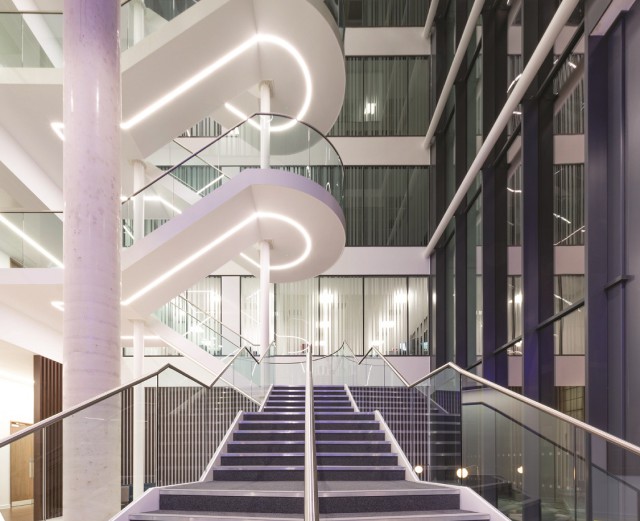Creating ever more productive environments

The combination of HCL and lighting control technology is creating ever more productive environments. Steve Marr explains.
Several studies in recent years have confirmed the positive effects of artificial lighting to positively influence employee wellbeing and comfort. This has led to a focus on human centric lighting (HCL)
HCL focuses on the influence of light on the natural circadian rhythm, the inner clock that manages the daily fluctuations of three key hormones – melatonin, cortisol and serotonin. Melatonin is a ‘natural soporific that is produced in the evenings and makes us relaxed. In contrast, cortisol and serotonin makes us more alert and mentally active and the actions of cortisol and serotonin are inhibited by melatonin. The natural light spectrum exerts its influences by affecting the cycling of these hormones. The purpose of HCL, therefore, is to mimic these effects of natural daylight to boost health, wellbeing, attentiveness and productivity.
Several studies in recent years have confirmed the positive effects of artificial lighting to support this circadian rhythm. According to the Building Research Establishment (BRE), people in Europe spend around 90 per cent of their time indoors and it is therefore clear that putting human health and wellbeing front and centre is vital. As well as improving productivity, any investment in a human centric lighting system will be returned through less absence through illness and highly motivated personnel. These effects manifest themselves in reduced accident risk, improved concentration and productivity, better visibility and a general ‘uplift’ in how we feel.
A Gensler survey found that 90 per cent of employees admitted that their attitude to work is adversely affected by the quality of their workplace environment. In fact, irregular circadian rhythm has been linked to various health conditions such as sleep disorders, obesity, diabetes, depression, bipolar disorder and seasonal affective disorder (SAD).
So how does it work? Our biological clock, which is located in the brain’s hypothalamus, receives input from our eyes and sends out signals about the time of day, so that our body can react. The circadian rhythm influences everything from eating habits and hormone release, to our ability to digest food and even our body temperature.
New and improved
Being indoors means we increasingly rely on artificial lighting but despite the significant improvements in LED technology, the primary driver for its use has been to save energy and ensure a fast return on investment. However, for those seeking to push the potential of LED as far as possible, the focus has shifted towards improving light quality and developing genuine insights into the non-visual effects of light. Specific attention is therefore being directed towards creating HCL solutions that mirror the effects of natural lighting as closely as possible.
As well as being particularly useful in commercial premises, HCL is also suitable for environments such as hospitals and schools. In the former it can aid the patient recovery process by positively influencing sleep/wake cycles, hormone release, eating habits and digestion. Meanwhile, schools can use it to both calm students and keep them alert, depending on the time of day.
Take back control
It goes without saying that the correct LED luminaire specification is a vital part of a successful HCL strategy but it’s only part of the picture. When integrated with lighting control technology it is possible to automatically change the colour temperature of the artificial light to mimic the cycle of natural light, taking into account the time of day, the position of the sun and even the time of year. Controllable, adaptable lighting systems therefore create more comfortable environments for people and can be used to stimulate people during the day through the use of bluer frequencies, and relax them at night with amber and red frequencies.
During the day powerful, bluish daylight suppresses the production of melatonin, thereby supporting the production of cortisol and serotonin and making us more alert. In the evenings, as daylight takes on a warmer, more reddish hue it stimulates the production of melatonin which, in turn, suppresses the cortisol and serotonin so that we naturally wind down.
Consequently, the more an artificial illumination system resembles the spectral range and distribution of natural sunlight, the better the quality of the light. The purpose of HCL, therefore, is to mimic these effects of natural daylight to boost health, wellbeing, attentiveness and productivity. This is achieved in a number of complementary ways:
• Matching the light output of artificial light to the natural spectrum.
• Varying the composition of the spectrum through the day to mimic natural changes – particularly in relation to the blue end of the spectrum.

• Using wide, flat luminous surfaces that are analogous to the sky dome.
• Directing light from the upper visual hemisphere into the eye.
In addition, the spectrum can be manipulated using these techniques to, for example, increase the alertness of workers on a night shift, thereby improving productivity and safety. The potential applications for HCL are discussed in more detail below.
The benefits can go much further though, as it is now possible to connect previously disparate building services such as heating, ventilation and lighting control to create a more ‘joined up’ approach to occupancy comfort.
By installing a networked lighting control system such as CP Electronics Rapid, it gives the user wide control. From the system head end, users can schedule colour temperature and brightness patterns for specific areas or across the whole building. They can design cyclic timed events determined by their own preferences specifically to generate the benefits that they are aiming for in their own environments, whether that is to calm for example or to stimulate.
However, there is now a balancing act between human centric lighting, wellbeing and quality of light, with dimming control and energy efficiency. So, the Rapid lighting control system offers users choice. While the system can be set to dictate the colour temperature; dimming via occupancy control and daylight linking can still be co-ordinated in order to lower energy consumption, and room occupants can even set their own preferences with local manual overrides.
Deep impact
Lighting control should be the rule rather than the exception and BS EN 12464, the European standard for lighting indoor workplaces, is having a significant impact. The standard addresses the design and development of lighting schemes around a specific task or activity and encourages designers to consider all available forms of lighting. It also provides guidelines about the use of lighting controls and recommends ways to illuminate rooms only when they are in use.
The use of lighting control also ensures compliance with Part L of the Building Regulations, which requires lighting to be controlled or locally switched. Not only that, it enables a building to demonstrate higher ratings in the Energy Performance Certificates and Display Energy Certificates that owners and managers are obliged to have.
One step beyond
The benefits of lighting control extend far beyond energy efficiency. It plays a key role in creating HCL systems that are more in tune with the circadian rhythm, leading to more productive working experiences and improvements in attention span, concentration and behaviour. Our understanding of the impact of light on the human body is still at an early stage and research on the effects of different types of illumination, the complexities of mimicking natural light, and what’s needed to apply artificial lighting safely and effectively is very much a work in progress. Watch this space.
Steve Marr is Product and Marketing Director of CP Electronics







